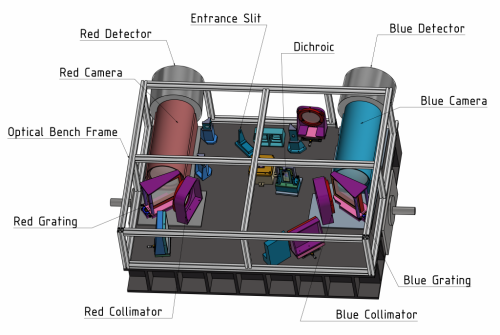On January 31 2022 the ESO Director General signed the agreement for the design and construction of the Cassegrain U-Band Efficient Spectrograph (CUBES), a very efficient, intermediate resolution spectrograph, that covers the UV region close to the atmospheric cutoff. The agreement was signed with Istituto Nazionale di Astrofisica (INAF), representing the consortium including INAF (Italy), the Science and Technology Facilities Council - UK Astronomy Technology Centre and Durham University (United Kingdom), Landessternwarte Heideberg (Germany), Nicolaus Copernicus Astronomy Center (Poland) and Instituto de Astronomia, Geofísica e Ciências Atmosféricas-Universidade de São Paulo and Laboratório Nacional de Astrofísica (Brazil).
CUBES Agreement Signature

Our atmosphere makes UV spectroscopy from the ground (300-380 nm spectral range) extremely challenging, nevertheless an instrument customised for that range offers a large increase of efficiency with respect to existing ESO instruments (UVES and X-Shooter). In addition, this spectral range is complementary to the ELT and JWST. An efficient UV spectrograph can cover a broad science case and will be a world-leading instrument for many years to come. CUBES will provide access to a tremendous diversity of iron-peak and heavy elements in stellar spectra, as well as some lighter elements (notably Beryllium) and light-element molecules (CO, CN, OH). The near-UV range is also critical in extragalactic observations, such as studies of the circumgalactic medium (CGM) of distant galaxies and in measuring the contribution of different types of galaxies/AGN to the cosmic UV background. Located at the Cassegrain focus, CUBES will cover the 300 - 400 nm spectral range with a resolving power of ~20K.
The current baseline design includes:
- A foreoptics sub-system that includes an Atmospheric Dispersion Corrector and an Acquisition and Guiding system;
- Two image slicers, enabling different spectral resolutions: ~22 K and ~6.5 K, minimise slit losses mitigating the unavailability of AO in the UV.
- Two arms, both equipped with first-order transmission gratings produced by microlithographic techniques with average efficiencies of 85% over the whole wavelength range.
- An active flexure compensation system to improve spectral format stability
- An advanced calibration subsystem that includes fibre fed simultaneous wavelength calibration alongside science spectra.
